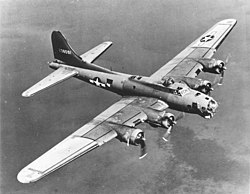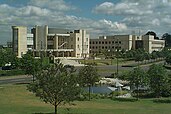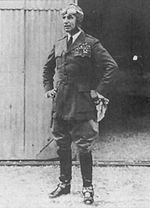| Main page | Categories & Main topics |
|
Tasks and Projects |
The Aviation Portal

Aviation includes the activities surrounding mechanical flight and the aircraft industry. Aircraft includes fixed-wing and rotary-wing types, morphable wings, wing-less lifting bodies, as well as lighter-than-air craft such as hot air balloons and airships.
Aviation began in the 18th century with the development of the hot air balloon, an apparatus capable of atmospheric displacement through buoyancy. Some of the most significant advancements in aviation technology came with the controlled gliding flying of Otto Lilienthal in 1896; then a large step in significance came with the construction of the first powered airplane by the Wright brothers in the early 1900s. Since that time, aviation has been technologically revolutionized by the introduction of the jet which permitted a major form of transport throughout the world. (Full article...)
Selected article
Selected image

Did you know
...that the Vickers machine gun was the standard weapon on all British and French military aircraft after 1916? ...that Frenchman Jean-Marie Le Bris accomplished the world's first powered flight in 1856, with a glider that was pulled behind a running horse? ... that 820 Naval Air Squadron was involved in attacks on the German battleships Bismarck and Tirpitz during the Second World War?
General images -
In the news
- May 29: Austrian Airlines cancels Moscow-bound flight after Russia refuses a reroute outside Belarusian airspace
- August 8: Passenger flight crashes upon landing at Calicut airport in India
- June 4: Power firm helicopter strikes cables, crashes near Fairfield, California
- January 29: Former basketball player Kobe Bryant dies in helicopter crash, aged 41
- January 13: Iran admits downing Ukrainian jet, cites 'human error'
- January 10: Fire erupts in parking structure at Sola Airport, Norway
- October 27: US announces restrictions on flying to Cuba
- October 3: World War II era plane crashes in Connecticut, US, killing at least seven
- September 10: Nevada prop plane crash near Las Vegas leaves two dead, three injured
- August 6: French inventor Franky Zapata successfully crosses English Channel on jet-powered hoverboard
Related portals
Associated Wikimedia
The following Wikimedia Foundation sister projects provide more on this subject:
-
 Commons
Commons
Free media repository -
 Wikibooks
Wikibooks
Free textbooks and manuals -
 Wikidata
Wikidata
Free knowledge base -
 Wikinews
Wikinews
Free-content news -
 Wikiquote
Wikiquote
Collection of quotations -
 Wikisource
Wikisource
Free-content library -
 Wikiversity
Wikiversity
Free learning tools -
 Wikivoyage
Wikivoyage
Free travel guide -
 Wiktionary
Wiktionary
Dictionary and thesaurus
Selected biography
Mitchell deployed to France in 1917 when the United States entered World War I. While there he was promoted to brigadier general and placed in command American combat air units in France. After the war Mitchell was appointed the deputy director of the Air Service became a passionate advocate of air power. In 1921 he set up a demonstration to show the capability of airpower against naval vessels. During the course of the demonstrations aircraft successfully sank a captured German destroyer, the light crusier Frankfurt, and the battleship Ostfriesland.
Mitchell regularly sparred with his superiors over the role of airpower in the military. In 1925 he was reverted to his permanent rank of colonel and was transferred to San Antonio, Texas. Later that year, after a series of aviation accidents he accused Army and Navy leadership of incompetence and "almost treasonable administration of the national defense." In response he was court-martialed for insubordination, found guilty, and sentenced to a five-year suspension from active duty. Mitchell resigned on 1 February 1926 in lieu of serving the sentence. He continued to advocate airpower as a civilian until his death in 1936. In 1942 President Franklin Roosevelt posthumously promoted Mitchell to major general in recognition of his contributions to air power.
Selected Aircraft

The Boeing B-17 Flying Fortress is an American four-engine heavy bomber aircraft developed for the U.S. Army Air Corps (USAAC). Competing against Douglas and Martin for a contract to build 200 planes, the airplane outperformed both the other entries and the Air Corps' expectations. Although losing the contract due to an accident, the Air Corps was so in favor of the B-17 that they ordered 13 B-17s regardless. Evolving through numerous design stages, from B-17A to G, the Flying Fortress is considered the first truly mass-produced large aircraft. From its pre-war inception, the USAAC touted the aircraft as a strategic weapon; it was a high-flying, long-ranging potent bomber capable of defending itself. With the ability to return home despite extensive battle damage, its durability, especially in belly-landings and ditchings, quickly took on mythical proportions.
The B-17 was primarily involved in the daylight precision strategic bombing campaign of World War II against German industrial targets. The United States Eighth Air Force based in England and the Fifteenth Air Force based in Italy complemented the RAF Bomber Command's night-time area bombing in Operation Pointblank, which helped secure air superiority over the cities, factories and battlefields of Western Europe in preparation for Operation Overlord. The B-17 also participated, to a lesser extent, in the War in the Pacific.
Today in Aviation
- 2012 – Eighty-four percent of U.S. domestic airline flights have arrived within 15 minutes of their scheduled arrival time since January 1, their best on-time performance since the United States Government began tracking their on-time performance in 1988 and an improvement from 77 percent between January 1 and June 30, 2011. They also set a record-low rate of baggage handling mistakes, misdirecting, damaging, or losing only three suitcases per 1,000 passengers on domestic flights between January 1 and June 30, 2012.[1]
- 2009 – Lithuanian airline Star1 Airlines commences operations.
- 2009 – Yemenia Flight 626, an Airbus A310-300 flying from Sana'a, Yemen to Moroni, Comoros, crashes into the Indian Ocean with 153 people aboard; one 12-year-old is found clinging to the wreckage.
- 2007 – A pilot attempting to return to the air after his small plane ran out of room on a wet runway slammed into a house in Arkansas Saturday, killing himself and a woman inside the home.
- 2007 – A small plane SABRE Lithium matriculation XASMR of ten seats, originating of Monterrey Nuevo Leo’n, piloted by its proprietor Daniel Reedbeds Insipid, confused to a flank of the airport Plan of Guadalupe.
- 1999 – A NAS Whiting Field, Florida, flight instructor bails out of a Beechcraft T-34C Turbo Mentor and parachutes to safety moments before the plane crashes near East Brewton, Alabama.
- 1994 – Airbus A330 test flight crash at Toulouse France (7 killed).
- 1989 – First flight of the Boeing 737-500
- 1985 – 39 remaining hostages from Flight 847 are freed in Beirut.
- 1978 – First flight of the Rutan Defiant
- 1977 – US president Jimmy Carter cancels the B-1 Lancer program
- 1975 – The United States Navy reclassifies all of its “attack aircraft carriers” (CVA) as “aircraft carriers” (CV); “nuclear-powered attack aircraft carriers” (CVA(N)) become “nuclear-powered aircraft carriers” (CVN).
- 1972 – The American 1972 bombing campaign against North Vietnam has destroyed 106 bridges, all of the country’s oil depots, and the pipeline running south to the Demilitarized Zone.
- 1971 – The crew of Soyuz 11, Georgi Dobrovolski, Viktor Patsayev and Vladislav Volkov, are killed after undocking from space station Salyut 1 after a three-week stay. A valve on their spacecraft accidentally opens when the service module separates, letting their air leak out into space. The capsule reenters and lands normally, and their deaths are only discovered when it is opened by the recovery team. Technically the only fatalities in space (above 100 km).
- 1968 – First flight of the Lockheed C-5 Galaxy
- 1967 – Thai Airways International Flight 601, a Sud Aviation Caravelle, crashes into the sea on landing at Kai Tak Airport, killing 24 of 80 on board.
- 1962 – Aeroflot Flight 902, a Tupolev Tu-104, is shot down by a missile near Voznesenka, Krasnoyarsk Krai; all 84 die in Russia's worst air accident at that time.
- 1959 – 1959 Kadena Air Base F-100 crash, A U. S. Air Force North American F-100 Super Sabre fighter suffers an in-flight engine fire over Okinawa. The pilot ejects safely, but the F-100 crashes into Miyamori Elementary School and surrounding houses in Uruma, killing 11 students at the school and six other people in the neighborhood and injuring 210 others, including 156 students at the school.
- 1956 – The 1956 Grand Canyon mid-air collision between United Airlines Flight 718, a DC-7 and TWA Flight 2, a Lockheed Constellation, over the Grand Canyon, kills all 128 aboard both planes; operating under Visual Flight Rules, the planes fail to see each other; the Federal Aviation Administration is created in the aftermath; the FAA establishes new rules for passenger carriers, among them the requirement to operate under Instrument Flight Rules, even in good weather.
- 1953 – A SNCASO S. O. 4000 (prototype of the Sud Vautour fighter-bomber) becomes the first European aircraft to exceed the speed of sound in a shallow dive.
- 1951 – United Airlines Flight 610, a Douglas DC-6, flies into a mountain in Larimer County, Colorado due to navigational error; all 45 passengers and 5 crew members are killed.
- 1951 – The second prototype Republic XF-91 Thunderceptor, 46-681, had an engine failure during takeoff from Edwards AFB, California. Republic Aviation test pilot Carl Bellinger escaped from the aircraft just as the tail melted off; total flight time was a mere ninety seconds. By the time fire apparatus arrived, driving seven miles (11 km) across the dry lake bed, the tail section had been reduced to ashes.
- 1950 – A Royal Canadian Navy Lt. Mervin C. “Butch” Hare of the 803 Naval Fighter Squadron departs from Montreal, Quebec in Hawker Sea Fury FB.11, TF997, but fails to arrive at home base of HMCS Shearwater, Dartmouth, Nova Scotia. Despite a massive international air search, nothing is found. In February 1968, two foresters discovered the wreckage in a remote area of Maine. The Sea Fury had struck a tree on top of the ridge with its port wing root and struck the ground within about 150 feet. The force of the impact dug a 15 foot diameter crater and the aircraft broke up and scattered, within a 50 yard radius. There had been several small fires. Lt. Hare’s parachute harness pieces were later found near the crater, ending an initial speculation that he had bailed out and perished somewhere else in the Maine woods.
- 1950 – P-51 Mustangs of No. 77 Squadron RAAF are sent to Korea as part of Australia's contribution to the war.
- 1947 – First flight of the Avions Fairey Junior
- 1947 – First flight of the Vickers Valetta
- 1943 – U. S. forces land on Rendova Island. A sweep by 27 Japanese Zero fighters over the area accomplishes little and almost is wiped out, and 43 U. S. aircraft bomb Munda Airfield. In the evening, a Japanese torpedo strike by 25 Mitsubishi G4 Ms (Allied reporting name “Betty”) escorted by 24 Zero fighters sinks an attack transport, with 17 of the G4 Ms shot down by U. S. Marine Corps F4U Corsairs and antiaircraft fire.
- 1943 – Since November 1, 1942, Italy has lost 2,190 military aircraft and suffered another 1,790 damaged.
- 1943 – Since June 1, the U. S. Army Air Forces‘ Eleventh Air Force has flown 407 sorties against Japanese forces on Kiska in the Aleutian Islands. U. S. Navy PV-1 Venturas have made additional night bombing attacks on the island.
- 1943 – Royal Air Force Bomber Command has lost 3,448 aircraft – About 1,600 of them to German night fighters – And about 20,000 aircrewmen on night raids since the beginning of World War II. Since April 1, Bomber Command has lost 762 aircraft, 561 of them to German night fighters.
- 1941 – No. 410 (Night Fighter) Squadron and No. 412 (Fighter) Squadron were formed in England.
- 1941 – German fighter pilot Werner Mölders shoots down five Soviet bombers, bringing his aerial victory total to 82. He becomes the first pilot to surpass the World War I record of 80 victories set by Manfred von Richthofen in 1918 and the highest-scoring ace in history at the time.
- 1930 – U.S. Navy Douglas PD-1 flying boat, BuNo A-7989, of VP-6 in the Hawaiian Islands, is lost in the Pacific off Hawaii, only six months after delivery. Airframe had only 42:40 hrs. flight time.
- 1926 – Alan Cobham sets out on a round trip from England to Australia in a de Havilland DH.50. He will arrive back in London on October 1 and receive a knighthood for his accomplishment.
- 1920 – A provisional establishment of 1340 officers and 3905 airmen for the CAF was authorized by Order-in-Council.
- 1911 – The Curtiss A-1 seaplane is tested for the first time by Glenn Curtiss.
- 1910 – The first airplane bombing tests are made as Glenn H. Curtiss drops dummy bombs from his own Curtiss biplane on the shape of a battleship marked by flagged buoys on Lake Keuka, New York.
- 1901 – At enormous personal risk, Herr Berson and Professor Süring of the Berliner Verein für Luftschiffahrt establish the first ratified altitude record for balloons. Their 8,510-cu. ft. balloon Preussen (Prussia) ascends to 35,435 feet.
References
- ^ Associated Press, "Carriers Do Better On Arrival Time, Liggage," The Washington Post, August 10, 2012, p. A9.
- Shortcuts to this page: Portal:Airplanes • P:AVIA
Purge server cache













































Recent Comments